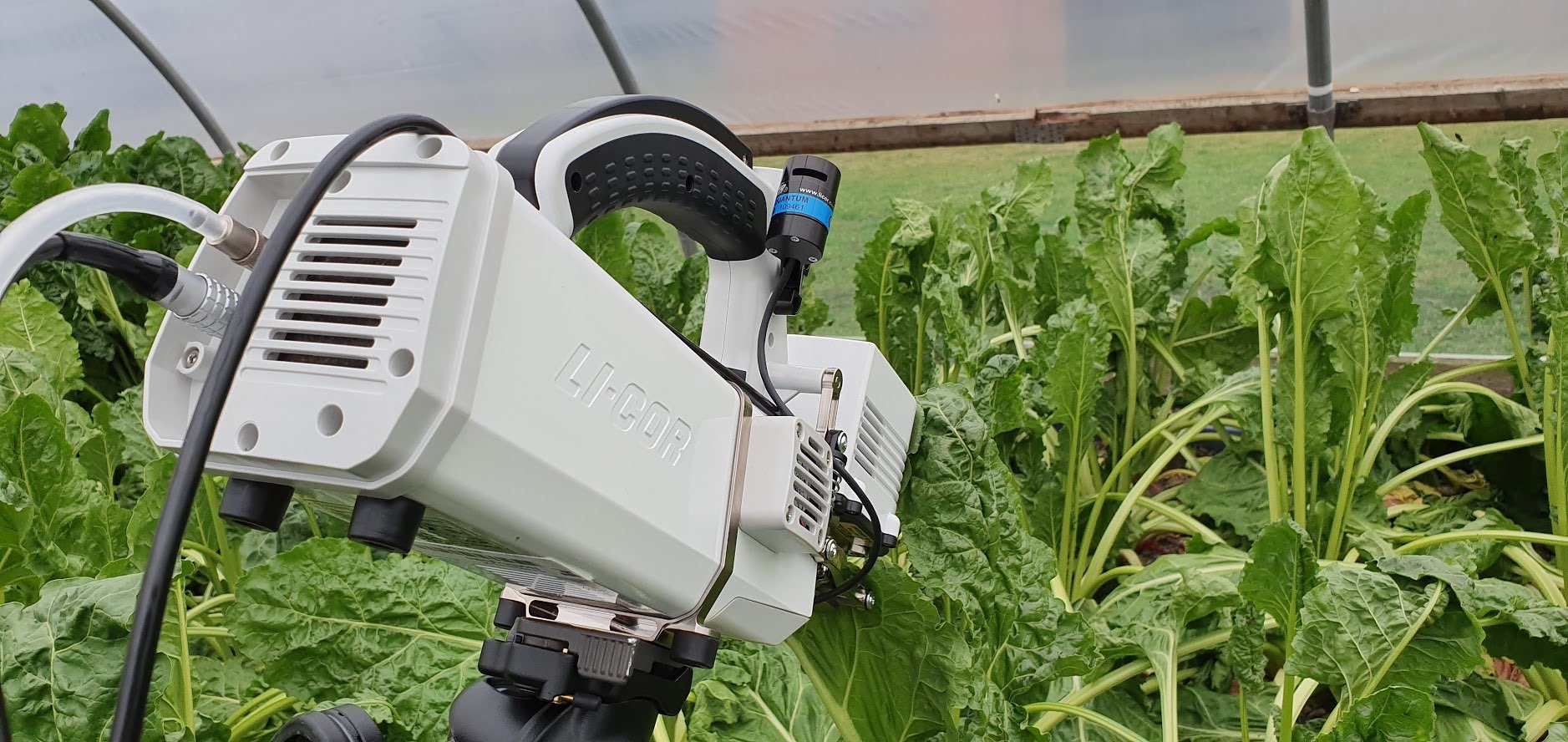
September 30, 2019, by Lexi Earl
Measuring carbon and water cycles in crop resource-use efficiency research
This post is written by Erik Murchie, Lorna McAusland, and Georgina Barratt
Plants are active day and night, performing myriad processes in metabolism, conducting environmental sensing and responding to stimuli. The processes that draw carbon and water from the environment and into the plant and that shift oxygen and water out of the plant (photosynthesis, respiration and transpiration) might not be visible to the eye but they are major physiological events on which our lives depend. Plants are some of the most sensitive organisms to changes in local conditions and climate. They have also been important factors in shaping crop adaptation and evolution to diverse environments during the last 10,000 years.
There is consensus that improved photosynthesis and efficiency of use of water, light and nutrients must underpin and drive yield improvements. This recently has driven the search for genetic variation in our crops. In turn, this has led to a renaissance of the demand for their measurement and innovation in instrumentation. The University of Nottingham has historically been a leader in research into crop resource-use efficiency and this continues today. Previous alumni of Sutton Bonington in this area includes John Monteith who co-developed the Penman Monteith equation used by the Food and Agriculture Organisation, to estimate global release of water from soil, plant canopies and water sources,and Roger Slack, co-discoverer of C4 photosynthesis.

Infrared gas analysis (IRGA) and chlorophyll fluorescence (CF) are the most published methods in plant physiology and over the last 30 years have transformed our understanding of how photosynthesis works. They have developed into highly sophisticated probes for plant physiological activity and health – they are portable and instantaneous. The Future Food Beacon have been using the latest version of one such ‘workhorse’ for this: the Licor 6800 (Li6800). We were delighted that three of these machines have been purchased to support crop resource use efficiency research across the School of Biosciences. With the Li6800, we can measure with great precision the rate and efficiency of carbon uptake and water loss. Moreover, we can tease apart the multitude of processes that drive photosynthesis and gas exchange, such as electron transport, enzyme activities and gas diffusion. The Licor6800s have so far been very busy with applications on several high-profile projects and we anticipate they will play a critical role in developing the field phenotyping capabilities of Nottingham and the Future Food Beacon in the coming years.

How is the Li6800 used?
The infrared gas analyser measures the exchange of both CO2 and water. This means the Li6800 not only measures the flux of CO2 for photosynthesis and respiration, but also the water released from the plant via its stomata. The Li6800 is invaluable in assessing the dynamic photosynthetic carbon uptake during the day (and respiratory loss at night) while also measuring the water loss, both during the day and at night. This has been useful for analysis in projects aiming to improve wheat, rice and sugar beet.
For example, the Li6800 has helped us characterise novel wheat lines for changes in photosynthetic CO2assimilation compared to modern, elite varieties. In addition, the Li6800 machines have helped us identify wild relatives of wheat with higher rates of CO2 uptake than their modern equivalents. These species could be used as potential candidates for introduction into modern crossing programs with the aim of improving photosynthesis. Below we showcase three case studies, all using the Li6800, to illustrate how equipment like the Li6800 adds to different projects.

Scientists receiving training on how to use the Licor6800 from Ian Smillie of Licor
Case study: Exploiting night-time traits to improve wheat yield and water use efficiency in the warming climate of northern Mexico. This project is funded by a Newton UK-Mexico scheme grant. Decreasing yield has been linked to increasing nocturnal temperatures in north-western Mexico. This project led by Assoc Prof Erik Murchie, with postdoc fellow Dr Lorna McAusland, seeks to determine whether some wheat varieties are better adapted to increases in nocturnal temperature and if so, why? Traits such as hydraulic conductance, respiration and nocturnal stomatal conductance may all contribute to nocturnal temperature resilience.
Case study: The International Wheat Yield Partnership (IWYP) and BBSRC project “Wider and Faster: high-throughput phenotypic exploration of novel genetic variation for breeding high biomass and yield in wheat”. This is a project (value £1.3m) run with The Nottingham BBSRC Wheat Research Centre which has developed novel wheat lines containing segments of DNA from wild, related species. These transferred segments introduce genetic variation into modern varieties with the aim of producing high yielding lines that are resilient or resistant to biotic and abiotic stress. Improvements in leaf-level photosynthetic carbon dioxide (CO2) uptake can be translated into improvements in whole plant biomass and, ultimately, grain yield.
Case study: Sugar Beet research at Nottingham. Sugar beet is a spring crop of great economic importance in the UK and the rest of Europe. The storage root of the beet is processed to produce white sugar, which is sold to the consumer solely under the Silver Spoon brand in the UK. With water being an increasingly limited resource, research into water use efficiency (WUE) is critical as sugar beet often wilt freely even when water is available in the soil. Led by Prof Debbie Sparkes, this research group is looking into soil-plant interactions to improve sugar beet productivity in partnership with the British Beet Research Organisation (BBRO). Researchers such as Georgina Barratt have been using the Li6800 to determine how sugar beet WUE is affected by water availability, in response to multiple water stresses, different lengths of water deficit, and how varieties recover.
No comments yet, fill out a comment to be the first

Leave a Reply